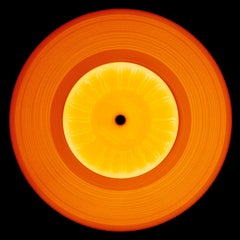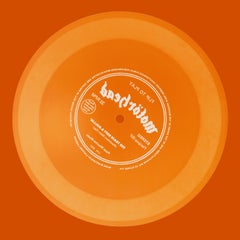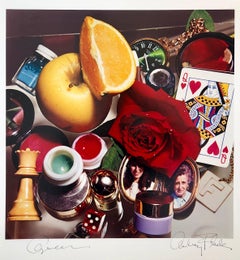Hand signed and titled in ink by the artist from edition of 50 (plus proofs). Color Photo printed at CVI Lab by master printer Guy Stricherz. Published by Prestige Art Ltd. From the color saturated 1980's. "Rolls Royce Lady" featuring a sculpture the Spirit of Ecstasy, a crystal goblet, dice, flowers, a pocket watch, jewelry, perfume and a red rose.
Audrey L. Flack (born May 30, 1931 in New York City, New York) is an American artist. Her work pioneered the art genre of photorealism; her work encompasses painting, sculpture, and photography. From Audrey Flack: 12 Photographs 1973 to 1983. A set of this portfolio is in the collections of the Harvard Art Museums. The Kodakchrome photos were photgraphed with a NIkon camera, the Ektachrome photographs were taken with a Hasselblad camera. Each negative was printed on a 20 X24 inche fiber based paper, dry mounted wth seal MT5 dry mounting tissue to 4 ply 100% cotton fiber board by Arnon Ben-David and Ari Rivera Gonzales under the supervision of Carol Brower.
Flack has numerous academic degrees, including both a graduate and an honorary doctorate degree from Cooper Union in New York City. Additionally she has a bachelor's degree in Fine Arts from Yale University and attended New York University Institute of Fine Arts where she studied art history. In May 2015, Flack received an honorary Doctor of Fine Arts degree from Clark University, where she also gave a commencement address.
Flack's work is displayed in several major museums, including the Museum of Modern Art, the Metropolitan Museum of Art, the Whitney Museum of American Art, and the Solomon R. Guggenheim Museum. Flack's photorealist paintings were the first such paintings to be purchased for the Museum of Modern Art’s permanent collection, and her legacy as a photorealist lives on to influence many American and International artists today. J. B. Speed Art Museum in Louisville, Kentucky, organized a retrospective of her work, and Flack’s pioneering efforts into the world of photorealism popularized the genre to the extent that it remains today.
Flack attended New York's High School of Music & Art. She studied fine arts in New York from 1948 to 1953, studying under Josef Albers among others. She earned a graduate degree and received an honorary doctorate from Cooper Union in New York City, and a Bachelor of Fine Arts from Yale University. She studied art history at the Institute of Fine Arts, New York University.
1953 New York University Institute of Fine Arts, New York City
1952 BFA, Yale University, New Haven, Connecticut
1948-51 Cooper Union, New York City
Career
Flack's early work in the 1950s was abstract expressionist; one such painting paid tribute to Franz Kline. Most influential amongst her early supporters was the Bauhaus artist Josef Albers. It was he who persuaded Flack to take up a scholarship at Yale with the mission of shaking up the institution's stuffy academic reputation. The ironic kitsch themes in her early work influenced Jeff Koons. But gradually, Flack became a New Realist and then evolved into photorealism during the 1960s. Her move to the photorealist style was in part because she wanted her art to communicate to the viewer. She was the first photorealist painter to be added to the collection of the Museum of Modern Art in 1966. Between 1976 and 1978 she painted her Vanitas series, including the piece Marilyn.
The critic Graham Thompson wrote, "One demonstration of the way photography became assimilated into the art world is the success of photorealist painting in the late 1960s and early 1970s. It is also called super-realism, radical realism, or hyper-realism and painters like Richard Estes, Chuck Close, and Audrey Flack as well, often worked from photographic stills to create paintings that appeared to be photographs."
In the early 1980s Flack's artistic medium shifted from painting to sculpture. She describes this shift as a desire for "something solid, real, tangible. Something to hold and to hold on to." Flack discusses the fact that she is self-taught in sculpture. She incorporates religion and mythology into her sculpture rather than the historical or everyday subjects of her paintings. Her sculptures often demonstrate a connection to the female form, including a series of diverse, heroic women and goddess figures. These depictions of women differ from those of traditional femininity, but rather are athletic, older, and strong. As Flack describes them: "they are real yet idealized... the 'goddesses in everywoman.'"
Flack has claimed to have found the photorealist movement too restricting, and now gains much of her inspiration from Baroque art.
Flack is currently represented by the Louis K. Meisel Gallery and Hollis Taggart Galleries. Her work is held in the collections of museums around the world, including the Metropolitan Museum of Art, The Museum of Modern Art, the Solomon R. Guggenheim Museum, the Whitney Museum of American Art, the Allen Memorial Art Museum, and the National Gallery of Australia in Canberra, Australia.
She was awarded the St. Gaudens Medal from Cooper Union, and the honorary Albert Dome professorship from Bridgeport University. She is an honorary professor at George Washington University, is currently a visiting professor at the University of Pennsylvania and has taught and lectured extensively both nationally, and internationally.
Flack lives and works in New York City and Long Island.
Audrey Flack is best known for her photo-realist paintings and was one of the first artists to use photographs as the basis for painting. The genre, taking its cues from Pop Art, incorporates depictions of the real and the regular, from advertisements to cars to cosmetics. Flack's work brings in everyday household items like tubes of lipstick, perfume bottles, Hispanic Madonnas, and fruit. These inanimate objects often disturb or crowd the pictorial space, which are often composed as table-top still lives. Flack often brings in actual accounts of history into her photorealist paintings, such as World War II' (Vanitas) and Kennedy Motorcade. Women were frequently the subject of her photo realist paintings. In her Neoclassical public sculpture of
gilded bronze angels...



